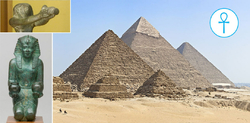- Retour accueil
- Vous êtes ici : Blog The Pyramids of the Cold The pyramids of the cold Section 19 • The Churning of the Ocean Hindu myth that produces the immortal life Amrita elixir is referring to the operating of the Great Pyramid of Giza
The pyramids of the cold Section 19 • The Churning of the Ocean Hindu myth that produces the immortal life Amrita elixir is referring to the operating of the Great Pyramid of Giza
Publié par Bruno Coursol dans The Pyramids of the Cold le 30/07/2022 à 14:41
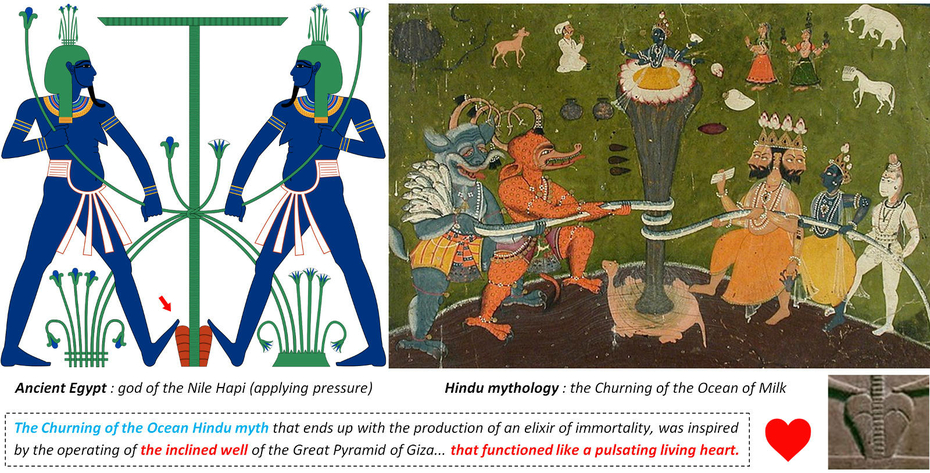
Dual depiction of Hapi (Hapy), the ancient Egyptian god of the Nile and its flood, in the sema-tawy motif of unification of the two lands, courtesy of Jeff Dahl : https://en.wikipedia.org/wiki/Hapi_(Nile_god)
The Churning of the Ocean, at the San Diego Museum of Art : https://www.flickr.com/photos/thesandiegomuseumofartcollection/6125128576/
Section 19 • The Churning of the Ocean of Milk Hindu myth was inspired by the Great Pyramid of Egypt operating cycle designed to achieve immortal life elixir production : Amrita is the Hindu version of sodium carbonate natron
In summary : we've seen in the last 18 previous Sections that the Great Pyramid of Giza was designed to cool down overheating chemical manufacturing of sodium carbonate and sodium bicarbonate, using the power of water that first needed to be pressurized by an impactor, over and over, most probably for days, maybe weeks or even months. At the time, sodium carbonate was called natron, and it was the salt used for the mummification of the pharaohs.
Manufactured natron gave to pharaohs eternal life. Natron made them immortals.
The amazing thing is that every single aspect of what I've just described here, is actually the core of one of the most important myth of the ancient World. The problem is that it is not originating from ancient Egypt, but from the Hindu mythology : it is the myth about Shiva and the "Churning of the Ocean of Milk" that ends up with the production of the Amrita, "the nectar of immortal life".
Hindu mythology was entirely created as a complete reinterpretation of ancient Egyptian accomplishments in the Great Pyramid and in particular the operating of the inclined well : the "Churning of the Ocean" is a perfect metaphor of the endless pounding of the inclined well by the impactor of the pyramid. It is the churning of the water of the well.
Not only did Hindu mythology reinterpreted the entire operating process of the Great Pyramid in text and art with the Churning of the Ocean, but they are also replicating today the most important part of the process : the creation of the fog of microdroplets that was giving birth to the evaporative cold. In the incredible and unique contemporary Ash Ritual performed during the Bhasm Aarti at Ujjain's Mahakaleshwar Temple, the fog of microdroplets is recreated by filling the sanctum with clouds of ash, the culmination of the ritual.
Ancient Egyptians didn't use the churning of water metaphor, instead they used another one because the functioning of the well could have also been compared to the functioning of the heart. In ancient Egyptian religion, the heart was considered the most important body part because the inclined well was the heart of the Great Pyramid. They put a scarab amulet on the heart of a deceased person because the hauling beetle of the Grand Gallery gave life to this heart.
Most probably, the heart symbol as we know it today, comes right from this metaphor of the inclined well functioning : the well of the pyramid was like a pulsating living heart.

Distinguished British men of science 1807-1808 assembled in the library of the Royal Institution, London. Mezzotint by W. Walker and G. Zobel after F. Skill and W. Walker, ca. 1860, after Sir J. Gilbert. The library at Wellcome Collection. https://wellcomecollection.org/works/t9jgbf8r/images?id=e9xkt35r
19.01 The 1800's Romanticism misguided vision of the ancient World
I hesitated for a long time before writing down this post, because the more things I discover about the ancient World, the most opposition I'll get. Everything we know of ancient times need to be revisited, completely revisited.
The problem about this period is that everything that had been written on the subject, is only based on the first assumptions made in the early 1800's : nothing had been proved wrong, nothing had been modified. Every historian simply added his own layer over the initial description of the ancient World.
The original sin about historians from the 1800's is that they fantasized an entire vision of the ancient World with very few data but with the boundless Romanticism ideology of their time. This fantasy has been in progress for over 200 years and it is still in effect today.
How could the Great Pyramid be a tomb for a pharaoh when there is absolutely no decoration anywhere in the structure? How the granite "sarcophagus" could have been designed for the pharaoh's body when there is, again no decoration anywhere on it? How could Nut be the goddess of the sky when her emblem is a water pot?
If the Great Pyramid would have been designed as a tomb, there would have been a town built all around it, so that people could worship and protect the pharaoh anytime. Nobody will ever have accepted to let pharaoh all alone in the dark at night when everybody else would stay together, secured inside the town boundaries, something like one kilometer away from him. Paraphrasing a popular expression "The church must be at the centre of village life".
What kind of structure do we build away from town? Production plants and industrial zones ! And that is precisely what the Great Pyramid was : a Solvay plant for sodium carbonate (natron) and sodium bicarbonate manufacturing.
We are in 2022 and the vision of the ancient World we have today is the exact same vision that had been fantasized in the 1800's, when at the same time, every other field of Human knowledge had been corrected and improved about a thousand times. What are we waiting for to truly pay tribute to our ancestors?

Ancient Egyptian amulet similar to E 12977, https://collections.louvre.fr/en/ark:/53355/cl010012629
Thousand lingas river, Kbal Spean, Cambodia, by BluesyPete : https://en.m.wikipedia.org/wiki/File:LingamCambodge2.JPG
19.02 A profound Change of Civilization Event that impacted the whole ancient World
We've already seen in Section 7 about ancient Egyptian god Bes, that the Great Pyramid had a tremendous impact outside Egyptian borders : modern Maori rugby players performing the Haka ceremonial dance are actually reproducing everything about Bes : 1/ His unmovable posture, 2/ His tongue out (the spitting metaphor), and 3/ His controversial cutting of the head gesture, because Bes was a metaphoric representation of the wedging block that immobilized the Taweret block, the bottom of the inclined well when the pyramid was in operation before the draining of the well shutdown procedure.
What ancient Egyptians accomplished during the first four Dynasties was a profound Change of Civilization Event : the whole world had to hear about it. It must have been so powerful and inspiring that it would have impacted ancient mythology all over the world, like it had in what is now New-Zealand and the Maori culture.
But ancient Egyptian accomplishments in physics and chemistry also had to inspire other civilizations in the ancient World, and it really is what happened in ancient Asia : the "Churning of the Ocean of Milk" and the Shiva Lingams of Hindu mythology are directly inspired by the Great Pyramid of Giza, and they are still worshiped today by hundreds of millions of people.
19.03 The copy-paste similarities between ancient Egypt and Hindu mythology [1] : the Thousand Lingas river
The impact and influence of ancient Egypt spread all over the world, as demonstrated by the above flooded carving in the "thousand Lingas river" in Cambodia. The similarities with the Egyptian "offering table amulet" are striking, even the 5 discs inside the structure are a perfect match. If we look closely, the 8 items on the "table" (2 baboons, 2 "masts", 2 dogs, one frog and one man) are also corresponding to the 8 outer discs on the Hindu interpretation.
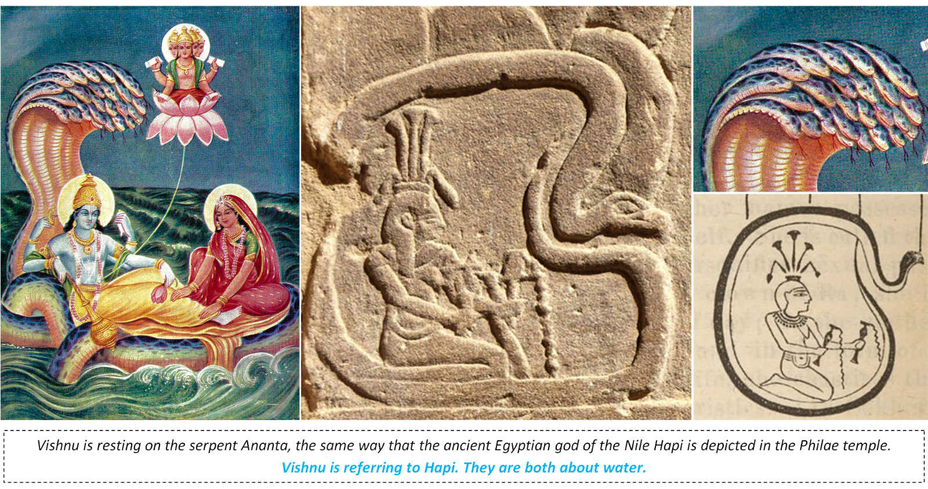
The creation of Brahma. In Vaishnava Puranic scriptures, Brahma emerges on a lotus from Vishnu's navel as Vishnu (Mahavishnu) creates the cosmic cycle. https://en.wikipedia.org/wiki/Brahma#/media/File:Sheshashayi_Vishnu.jpg
God of the annual inundation of the Nile Hapi, creating the first snake with his own water (snake = water), in the Isis temple, North wall of the Gate of Hadrian, Philae, Egypt : http://www.temples-egypte.net/philae/hadrien/paroiNord/registreMilieu.html
19.04 The copy-paste similarities between ancient Egypt and Hindu mythology [2] : The Hindu reinterpretation of ancient Egyptian god of the Nile Hapi into Vishnu
Vishnu sitting onto the body of a great snake and positioned like he is protected by it, isn't the only god of the ancient World who is depicted in this exact same position : god of the Nile Hapi, in a relief in the Isis temple at Philae, is doing it too.
What is striking is that on the above set of images, pretty much everything is representing water : ancient Egyptian god of the Nile Hapi is water, Hindu gods Vishnu and Brahma are water and the snakes on which they are sited on are also water. Like usual, Hindu mythology is showing a lot more than its original Egyptian counterpart : water is also represented as it is, without the use of any metaphor.
Figure of Kurma, the Tortoise incarnation of Vishnu in the Ashmolean Museum of Art and Archaeology at the University of Oxford, England : http://jameelcentre.ashmolean.org/collection/7/10230/10264/all/per_page/50/offset/0/sort_by/seqn./object/11166
Kurmavatara, tortoise incarnation of Vishnu, from Garhwa, Prayagraj District : https://upload.wikimedia.org/wikipedia/commons/4/4f/Kurmavatara_%28tortoise_incarnation_of_Vishnu%29%2C_from_Garhwa%2C_Allahabad_District.jpg
19.05 Vishnu getting out of the Tortoise's mouth is a reinterpretation of pressurized water ejected from the well
What is incredible on the above figure of Kurma, the Tortoise incarnation of Vishnu, at the Ashmolean Museum, is that the shell of the Tortoise is a perfect copy of the Heart shape element on which ancient Egyptian god of the Nile is stepping on the sema-tawy motif, the union of "Lower and Upper Egypt".
If this Heart shape element is the representation of the inclined well, because of its heart-like functioning, then the Tortoise is also a representation of the Heart/inclined well.
Because the inclined well was producing pressurized water, then what is getting out of the Tortoise's mouth is pressurized water.
Vishnu is pressurized water, getting out of the inclined well. In other words, Vishnu is a reinterpretation of ancient Egyptian god Atum.
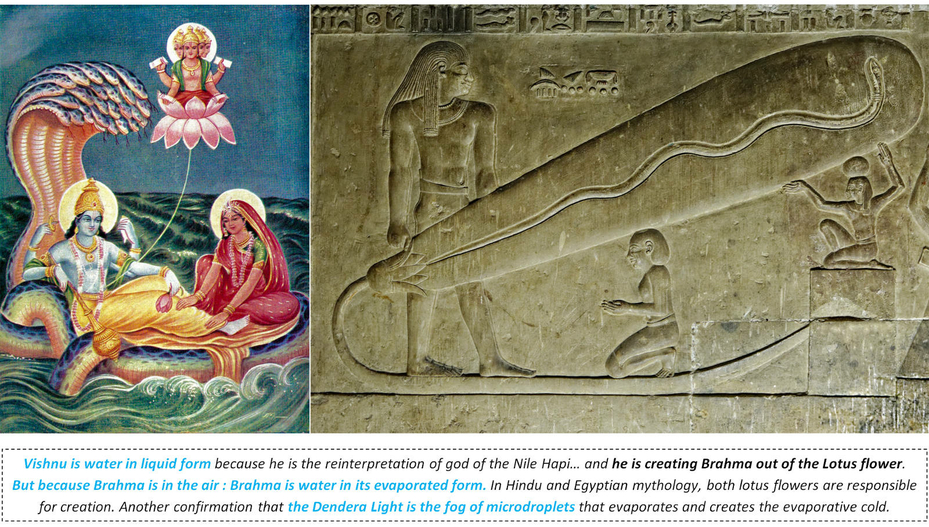
In Vaishnava Puranic scriptures, Brahma emerges on a lotus flower from Vishnu's navel as Vishnu (Mahavishnu) creates the cosmic cycle. Shaivite texts describe that Shiva told Vishnu to create, Shiva ordered Vishnu to make Brahma : https://en.wikipedia.org/wiki/Brahma. Dendera Light photograph thanks to Kairoinfo4U and posted on flickr : https://www.flickr.com/photos/manna4u/14525094039/in/photostream/
19.06 The creator Hindu god Brahma and the lotus flower
"Brahma (Sanskrit: ब्रह्मा, romanized: Brahmā) is a Hindu god, referred to as "The Creator" within the Trimurti, the trinity of supreme divinity that includes Vishnu, and Shiva. He is associated with creation, knowledge, and the Vedas. Brahma is prominently mentioned in creation legends."
https://en.wikipedia.org/wiki/Brahma
We've seen that Vishnu is referring to water in liquid form because he is the reinterpretation of god of the annual inundation of the Nile Hapi, but Vishnu is also creating Brahma out of the Lotus flower. This is the post about the Dendera Light all over again : the Creation is about the fog of microdroplets and the evaporative cold.
If Brahma is in the air, it is because Brahma is water in its evaporated form.
Of course, again, everything here has to be taken metaphorically. I'm not saying that Hindu mythology is the same thing as the ancient Egyptian religion. The Hindu mythology is a complete reinterpretation; the creator god Brahma is not "really" water in its evaporated form.
I'm just interested in finding out the real origin of things, the real foundation on which they were built. From these foundations, Hindus did construct an entire new mythology, that simply originates in ancient Egypt with the Great Pyramid.
The same way Atum is producing the evaporative fog of microdroplets through the lotus flower, and so creating the cold (the fog = Amun), Vishnu is also creating Brahma through the lotus flower.
If Vishnu = Atum, then Brahma = Amun
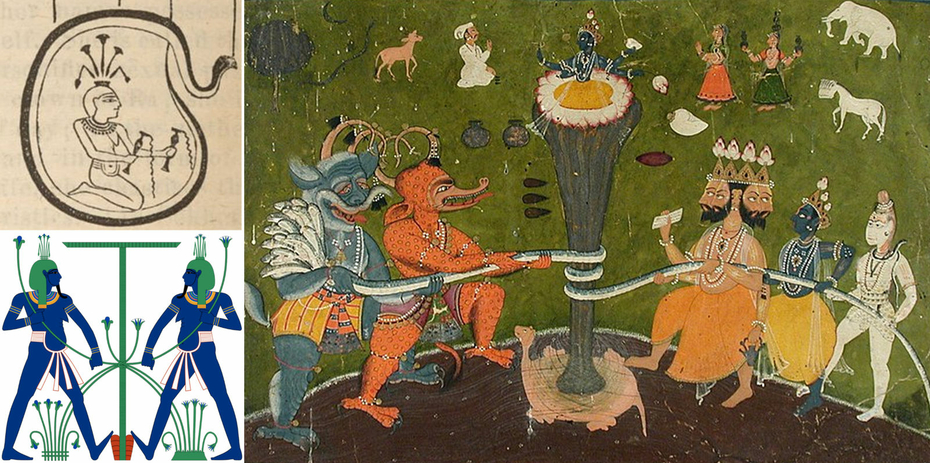
Everything about the "Churning of the Ocean" Hindu myth is inspired by ancient Egyptian God of the Nile Hapi, who was creating a snake out of his own water. The snake in the Churning of the Ocean is Vasuki, Lord Shiva's snake.
"Vāsuki took part in the incident of Samudra manthana by allowing both the devas and the asuras to bind him to Mount Mandara, so that they could use him as their churning rope to extract the Amrita from the ocean of milk". https://en.wikipedia.org/wiki/Vasuki
19.07 The copy-paste similarities between ancient Egypt and Hindu mythology [3] : the Churning of the Ocean of Milk
We've seen that the entire ancient Egyptian religion was only about the glorification of the scientific and technological accomplishments in physics and chemistry, and that the whole story could be summarized as follows : natron was manufactured for the mummification of the pharaoh in order to assure him eternal life, and the key point of the process was the cooling of the chemical manufacturing reactions. Water was used for the cooling, but not directly : evaporative cooling was created after the pressurization of the water of the inclined well of the Great Pyramid, using an impactor, endlessly pounding the waters.
The fact is that everything I've just said here, actually does appear in one single myth that every historian knows about. But there is a catch, a little twist : this myth doesn't come from Egypt, but from Hinduism, and it is the Churning of the Ocean of Milk, the Samudra Manthana.
19.08 The Churning of the Ocean of Milk [1] : Summary of the myth
"Hindu history also contains a story about the churning of the Cosmic Ocean in order to obtain Amrita – the nectar of immortal life. At the suggestion of Vishnu, the devas and asuras churn the primeval ocean in order to obtain Amrita which will guarantee them immortality. To churn the ocean they used the Serpent, Vasuki, for their churning-string. For a churning pole they used Mount Mandara placed on the back of a Great Tortoise – the Kurma Avatar of Vishnu. As the gods and demons churned the sea, the terrible poison Halahala issued from its depths and began to envelop the universe with its choking fumes. Gasping for breath, the devas and asuras sought the help of Shiva, who valiantly took the poison into his throat and swallowed it. Shocked by his heroic act, the Goddess Parvati grasped him by the throat, trapping the poison there and preventing it from spreading; but, such was the strength of the poison, that it turned his neck blue, thereby earning him the name of Neelakantha (blue-throated one)." https://en.wikipedia.org/wiki/Kshira_Sagara
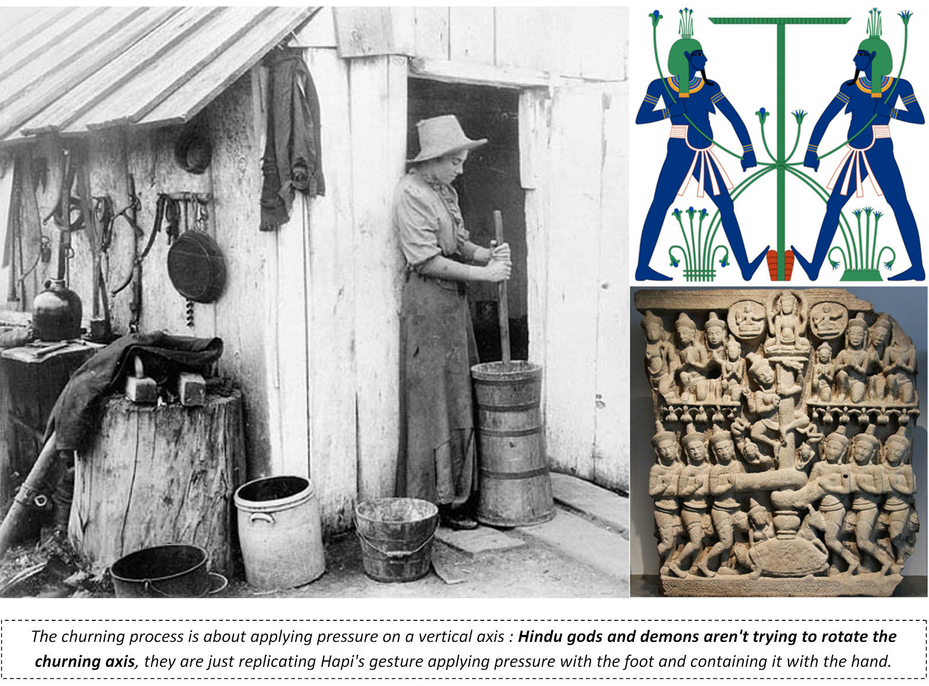
The churning process is about applying pressure on a vertical axis : Hindu gods and demons aren't trying to rotate the churning axis, they are just replicating Hapi's gesture applying pressure with the foot and containing it with the hand. Canadian farm girl churning butter, 1893 by Bayley, W. Braybrooke, 1857-1939, on Wikipedia (Churning butter) : https://en.wikipedia.org/wiki/Churning_(butter), image from Library and Archives Canada (reproduction reference number PA-126654)
The churning of the ocean of milk, Cambodia, Prasat Phnom Da, Angkor vat style, first half of the XIIth century, sandstone. Musée Guimet, Paris (Barattage de l'ocean de lait, Cambodge). Image courtesy of Ddalbiez : https://fr.wikipedia.org/wiki/Fichier:Barattage_de_l%27ocean_de_lait.jpg
19.09 The Churning of the Ocean of Milk [2] : The Overheating and Sequential Water Cooling references
"When gods and demons started churning the Ocean of Milk to obtain the elixir of life (Amrita), the first thing that came out of it was Halahala or Kalakuta. It is a very lethal poison. This poison is so dangerous that it could annihilate all the creation. Therefore, gods and demons requested Lord Shiva to drink it, as he was the only one who could do it. Lord Shiva granted their request and drank the poison, but if the poison had spread in his body, it would have been very painful for him. Therefore, Goddess Parvati stopped the poison at his throat before it entered his body by placing her hands over. Even though the Halahala is in the throat of Lord Shiva, it produces a lot of heat in his body. Therefore, Lord Vishnu ordered gods to pour water on Lord Shiva to reduce the heat in his body. Therefore, to reduce heat in his body and soothe his pain, a vessel full of water is always hung over a Shiva Linga, and water drops 24×7 on it." https://www.hinduismfacts.org/why-are-water-drops-made-to-drip-on-a-shiva-linga/
This is a perfect metaphoric description of the overheating Solvay process that ancient Egyptians had to face off : to produce the substance that would give immortal life to pharaoh (like the Amrita elixir of life), they designed the Great Pyramid to create cold, using the power of water in a magical way : evaporative cooling.
It is important to note that the cooling was not continuous : it was a sequential process. Maybe every 10 or 15 minutes, the impactor pressurized the inclined well waters and created the cold, without ever stopping, probably for weeks or months.
What is incredible is that the Churning of the Ocean myth is perfectly accurate also on this particular aspect : it is not said that water had to be constantly poured on a Shiva Linga, but only drop after drop and 24x7, without ever stopping.
The Churning of the Ocean of Milk Hindu myth, showing Mount Mandara on top of Kurma (Vishnu as a tortoise). Gods are on the left : Brahma with four heads, then Vishnu (blue), Shiva (white) and four over gods. On the right are the 10 asura demons holding the head of the great snake Vasuki.
Source Gallica / Bibliothèque nationale de France, département Estampes et photographie : https://gallica.bnf.fr/ark:/12148/btv1b55007286v/f63.item
19.10 The uprooted Mount Mandara is the Great Pyramid made of quarried stone blocks
"The Samudra Manthana (Sanskrit: समुद्रमन्थन; lit. 'churning of the ocean') is a major episode in Hindu mythology that is elaborated in the Vishnu Purana, a major text of Hinduism. The Samudra Manthana explains the origin of the elixir of eternal life, amrita. The churning of the Ocean of Milk was an extensive process: Mount Mandara was uprooted and used as the churning rod." Also : "While carrying the massive mountain, several devas and asuras fell to their deaths and some perished due to sheer exhaustion."
https://en.wikipedia.org/wiki/Samudra_Manthana
The reason that explains Mount Mandara was the Great Pyramid, is the fact that it had been described as "uprooted" : blocks were taken out of a massive mountain, and put somewhere else. It is a perfect metaphor of the quarried stone blocks used to build the pyramid.
"Mount Mandara was used as the churning rod" indicates that it represents the structure used to achieve the act of churning : again, it indicates that Mount Mandara is the Great Pyramid.
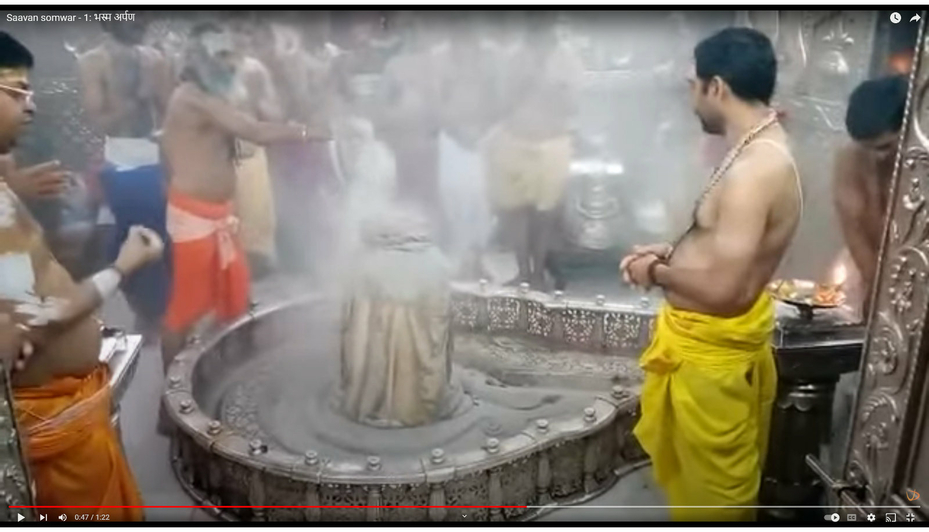
The recreation of the fog of microdroplets of the Great Pyramid, with a cloud of ashes, in the Savan Somwar Hindu ritual. Video 1 (thanks to nittivijay) : https://www.youtube.com/watch?v=g_1pu39kPfc&t=82s
19.11 The ash cloud recreation of the fog of microdroplets of the Great Pyramid is the culmination of modern Hindu rituals
If you haven't already seen a traditional Hindu ritual, well I guess you're probably gonna be stunned, almost shocked, amazed and fascinated, like I was the first time I discovered this kind of ritual were still performed today.
The above screenshot comes from a video where ash is thrown upon a Shiva Linga, so that a cloud of ash is created and fills the entire sanctum.
I may be wrong here, but I think that this cloud of ashes, that is the culmination of the entire ritual, is produced in the sole purpose to recreate the mist of microdroplets that was created into the Horizontal passage of the Great Pyramid to create evaporative cold. In other words, the meaning of the Ash Ritual, is not to put any ash onto the Shiva Linga, but to create the ash cloud in the air.
That explains why the Shiva Linga (or Shivlinga) is veiled with a cloth for that part of the ritual : the ashes are only meant to fill the air.
The whole point of the Churning of the Ocean / Churning of the waters of the inclined well, was to produce that mist, that fog, that cloud.
Ancient Egyptians represented this fog in the Dendera temples in its original oblong shape, the Dendera Light bulbs, and Hindus are reproducing it the best they can, with ashes.
Please, watch the video (this is a very short one, 1 minute).

19.12 "Bhasm Aarti at Mahakaleshwar, Ujjain. A Divine Experience not to be Missed"*
"Ujjain, located on the banks of river Shipra is a beautiful temple town and home to one of the 12 jyotirlingas- Mahakaleshwar Jyotirlinga. The word Mahakaleshwar means 'the lord of time' and according to Hindu beliefs, Lord Shiva is the God of time.
A unique ritual associated with the temple is Bhasm Aarti which begins every day at 4 am. People from all walks of life visit Ujjain with a desire of beholding this lifetime experience. The early morning peaceful and calm environment at the temple is what fills you with immense positivity.
In the past, Bhasm Aarti was performed with ash from the first funeral pyre cremated at night. But with the changing times, this practice has changed and fresh ash is prepared from cow dung.
The process begins with the 'Abhishek' or the ritual bath of the shivling then smearing it with multiple offerings like curd, honey, sandal paste and finally cleaning it with milk and water. Further, the Shivling is decorated with elaborate arrangements of flowers and especially the Bel leaves that are considered to be very dear to Lord Shiva are also offered.
The process however doesn't end here. There is more to witness even before the ash ritual is performed. Through the application of various substances, the shivlinga is transformed into a divine face and then further embellished with garlands.
After this hour-long process of bathing and decorating the idol comes the most-awaited and interesting part associated with this first aarti of the day. The entire shivlinga is veiled with a cloth in a manner that the decoration is not disturbed. Thereafter, the head priest swings the ash-filled pouch on the shivling. The entire sanctum is filled with clouds of ash covering the shivling in the grey dust. This process of sprinkling ash on the Shivling lasts a minute.
This is followed by performing Aarti with lit oil lamps, the clanging of bells, and the chants of 'Om Namah Shivay' and 'Har Har Mahadev'. When you are able to witness this entire process and the aarti starts, you just feel that you have experienced one of the most beautiful things in life."
*Thanks to Madhya Pradesh Tourism : https://www.mptourism.com/bhasm-aarti-at-mahakaleshwar-and-ujjain.html
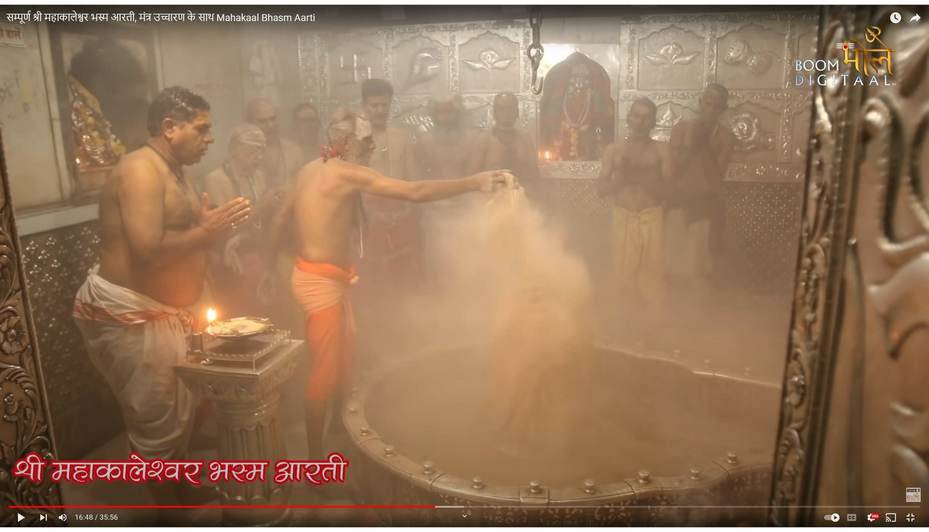
Long video of the entire Mahakal Bhasm Aarti Hindu ritual, thanks to Boom Bhole Digital (Bhaavna Israni).
Video 2 (the ash ritual starts at 14.45) : https://www.youtube.com/watch?v=sfULEEzBUmE
19.13 The Bhasm Aarti at Ujjain's Mahakaleshwar Temple*
"Mahakaleshwar temple at Ujjain, in the Malwa region of Madhya Pradesh, is an important pilgrimage place for Hindus as it's said to be one of the 12 Jyotirlingas (most sacred abodes of Shiva). It's also regarded as one of the top 10 Tantra temples of India, and has the only bhasm aarti (ash ritual) of its kind in the world.
The unique thing about this aarti is the inclusion of bhasm, which is ash from funeral pyres, as one of the offerings. Mahakaleshwar is a name for Lord Shiva and means the god of Time or Death. This may be one of the reasons for the inclusion of the funeral ash.
The entire aarti lasts for about 45 minutes to an hour. The first part of the aarti, while the shringar is done, is sublime and well worth the scramble. However, the actual bhasm part — which is often hyped to no end — lasts only about a minute and a half.
During this crucial minute and a half that you wait to watch from 2 a.m., women are asked to cover their eyes. It's important to note that the bhasm being used is no longer from funeral pyres but actually just vibhuti – the sacred ash used in most temples, sometimes made from powdered cow dung.
After the Lord is adorned in the bhasm, the actual aarti begins, with the offering of the lamps. The aarti is usually accompanied by chants of praises to the Lord."
*Article by Sharell Cook (06/26/2019) and posted on https://www.tripsavvy.com/mahakaleshwar-temple-at-ujjain-guide-1539494
19.14 Are the four holy months of Chaturmas referring to the operating time of the Great Pyramid?
If everything about Hindu mythology has been built on the ancient Egyptian operating of the Great Pyramid, maybe it is gonna be possible to find some clues on how long and when was the pyramid really operated, in other words, how long and when was the evaporative cold created.
Contrary to ancient Egyptians, Hindus didn't hide things so much : they didn't hide the fact that everything was centered on water. In Hindu mythology, everything is about water. During rituals, including the Bhasm Aarti at Ujjain's Mahakaleshwar Temple, water is poured on the Shiva Linga many times and some Lingas had even been carved in the rocky bottom of some sacred rivers.
Hindu mythology is also perfectly describing the functioning of the inclined well with the Churning of the Ocean metaphor. So, when I stumbled on the Chaturmas thing, I got pretty interested.
Beginning the day of Harishayini Ekadashi in June/July, Hindus in Nepal and India mark a special period dedicated to Lord Vishnu and his embodiments for the next four months until the day of Haribodhini Ekadashi in October/November, and it is known as the Chaturmas (literally, four months). Source : onlinekhabar.com
What if these 4 holy months are referring to the actual operating time of the Great Pyramid?
From a strict calendar point of view, it would be possible, because we know that the pyramid was supplied exclusively with the water of the Nile during the annual inundation, and that this inundation started in July, like the Chaturmas does today.
19.15 How long and how many times was the Great Pyramid functioning?
The question now would be to know if the Great Pyramid was used just one single time for a period of about 4 months, or on the contrary, if it was operated for many years.
Personally, and because the pyramid had such an enormous impact on the ancient World (the Maoris and the Hindus, at least), I'll tend to rule out the unique operating time hypothesis. In my opinion, it is even possible that the pyramid was used over many generations. It doesn't imply that the operating occurred every year, but why not every single pharaoh, had to operate the pyramid at least one time during his kingdom, to prove that he was legitimate to rule Egypt?
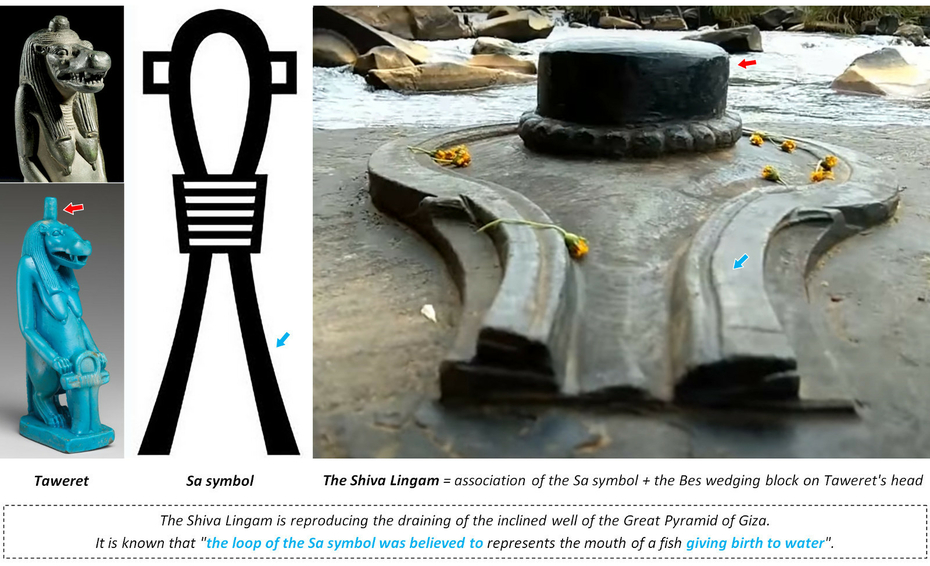
Shiva Linga at Sahasralinga, near Sirsi. Sahasralinga is a pilgrimage place, located around 14 km from the Sirsi Taluk in the district of Uttara Kannada of Karnataka state in India. It is in the river Shalmala and is famous for being the location where around a thousand lingas are carved on rocks in the river and on its banks (source Wikipedia : https://en.wikipedia.org/wiki/Sahasralinga). Video by High Level Computing, screenshot at 4.49 : https://www.youtube.com/watch?v=jlxpIYKE1ho
19.16 Shiva Lingam is the association of the Bes wedging block that protected the dormant drain hole of the well, with the representation of the draining of the well itself, the Sa symbol
What I'm saying about Hindu mythology being a complete reinterpretation of the ancient Egyptian religion that was mostly entirely based on the operating of the Great Pyramid, doesn't mean it is simply a copy.
On the contrary, a reinterpretation means that Hinduism completely distanced itself from its Egyptian origin, even if everything about Hinduism can be traced and explained by ancient Egypt.
For example, one of the most important act of worship that is still done today, is about putting water, milk or butter onto the Shiva Linga, the representation of Shiva. The fact is that without even knowing it, Hindus are reproducing the draining of the inclined well of the pyramid.
We've seen that Maori rugby players were already reproducing a crucial part of the functioning of the inclined well by mimicking the Bes wedging block that immobilized the bottom of the well Taweret block, and this is not surprising because the well, the Heart of the pyramid would have been one of its most important part.
Hindus putting water onto the Shiva representation are also in some ways, worshiping Bes. The protruding block of the Shiva Lingam is Bes, and the Yoni part is a Sa symbol.
We've already seen that the Sa symbol was a representation of the draining of the well, and that ancient Egyptians themselves believed that it was giving birth to water.
In summary, Shiva Lingam are the association of the Bes wedging block that protected the dormant drain hole of the well, with the representation of the draining of the well itself, the Sa symbol.

Hatshepsut’s birth scene, from Édouard Naville "The Temple of Deir el Bahari" (London, 1896), vol. 2, pl. 50. Image courtesy of the University Library Heidelberg, The Ebony shrine, northern half of the middle platform : https://digi.ub.uni-heidelberg.de/diglit/naville1896bd2/0050
19.17 The meaning of the Sa symbol
It is important to understand that during the entire operation of the Great Pyramid, hence the creation of the evaporative cold, the bottom of the inclined well was what is now known as the upper granite plug. That crucial block has been deified into the goddess Taweret and was like suspended in mid-air, blocked by a smaller granite block set in the floor of the ascending passage : the wedging block that was deified into the deity Bes. Sections 6, 7, 8 and 9.
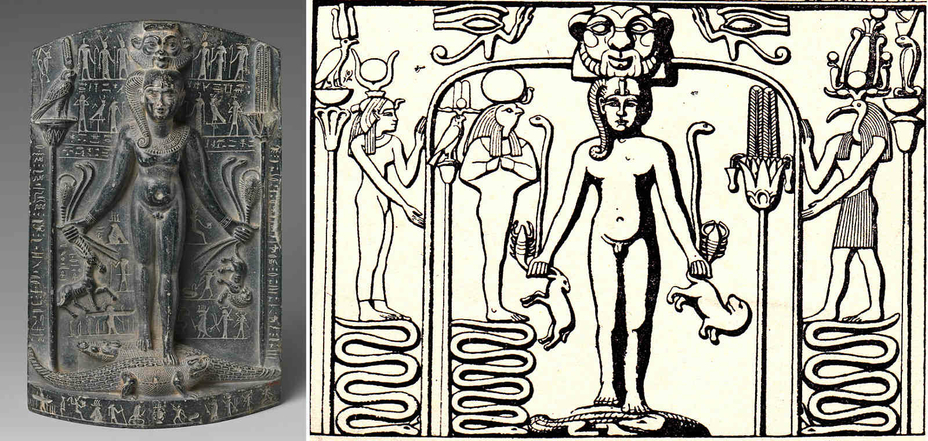
Magical Stela or Cippus of ancient Egyptian god Horus the Child "The Savior", 332–280 B.C.E (Ptolemaic Period) from the Metropolitan Museum of Art in New-York : https://www.metmuseum.org/art/collection/search/545766
Draw of the Metternich stela, by E. A. Budge "The Gods of the Egyptians 2" (1904). Original at the Metropolitan Museum of Art : Magical Stela (Cippus of Horus), 360–343 B.C.E. Late Period https://www.metmuseum.org/art/collection/search/546037
19.18 Horus the Child is the Shock Absorber block of the inclined well : under Bes and without even touching the floor
Until today, I perfectly described Bes and Taweret as representations of the wedging block that maintained in position the bottom of the inclined well block. This couple stayed in place during the entire operating of the Great Pyramid. For the draining of the well, water height was augmented and the pressure broke the wedging block.
But if nothing had been done to stop Taweret, the block would have destroy the real bottom of the ascending passage and the descending passage would have been inoperable : the man that triggered the whole thing from the inside of the shelter of the grotto wouldn't have been able to exit the pyramid.
So, a shock absorber block had been implemented right under the Bes block. This so particular block would have just been set in position "free" so to speak : it was designed to move freely in the bottom of the passage and absorb the energy of Taweret, pushed by an enormous pressure due to water.
Another way of saying it, is that this absorber shock block wasn't touching the real floor of the well : from the inclined well point of view, this block was only in contact with its walls. The floor of the ascending passage is not the floor of the inclined well : it is just a wall.
So, the shock absorber block was set under Bes, and it didn't touch the floor so it could move freely against the walls of the well. Well, that is precisely what the Magical Stelae is all about : Horus the Child "The Savior" is set right under Bes' head and he doesn't touch the floor.
Horus the Child is shown striding on top of crocodiles because he wasn't suppose to touch the floor.
His epithet "The Savior" could be referring to the fact he protected the integrity of the well, or the man in the grotto in some way, or something else.
19.19 The water poured onto Magical Stelae…
In Section 19.13 I'm talking about the fact that ancient Egyptians used to hide things way better than the Hindu mythology did, but apparently something started to change in the very late period, and water started to be used in Egyptians rituals, pretty much the same way that water was used in the rituals.
" Cippi, or magical stelae, represent Horus’s healing from scorpion stings and snakebites in the marshes. Egyptians believed that a liquid poured over a magical stela could absorb and transfer the power of the stela’s spells and images to the worshipper. Traditional Egyptian magic and religion such as this thrived throughout the fourth and third centuries B.C.E. despite the largely non-Egyptian origin of the country’s rulers at that time." https://www.brooklynmuseum.org/opencollection/objects/3684
Could it be possible that because Egypt was ruled at that time mostly by pharaohs who weren't born in the country, that the constant use of water in Hindu rituals influenced Egyptian religion?
19.20 … and the vomiting serpent
We've seen in Section 5 that the Great Serpent Apep (Apophis) was the metaphoric glorification of the pressurized waters of the inclined well and that a small amount of it was redirected towards the evaporative cooling passage, every 10 or 15 minutes or so. That sequential ejection of pressurized water is exactly what is describing Magical Steala with the vomiting snake metaphor.
We also have here the same story than in the Churning of the Ocean : a god that is healing poison burn.
"The main function of the Metternich Stela was for the magical healing of poisons, mostly caused by animals. Water was poured over the Stela and collected. The water from the Stela was then drunk by the person suffering from the poisonous ailment. That person would identify with the child Horus who had also suffered such tragedies. During the entire process religious rites from the Stela were recited by local priests.
The first few spells on the stela are related to reptiles and other harmful creatures. The most prominent was the serpent demon Apophis who was the enemy of Ra for he is the equivalent of the devil. The spell forced the serpent to decapitate and burn into pieces. The second half of the spell would force the serpent to vomit and while the priest recited this spell the person inflicted would also vomit freeing their body of the poison.
The next spell was directed towards a cat. The cat contained a bit of a god or goddess and would be able to destroy any sort of poison. The spell asks for Ra to aid the cat in her time of need.
Most of the Stela has inscriptions that describe stories such as the ones above in relation to being poisoned and spells to be cured."
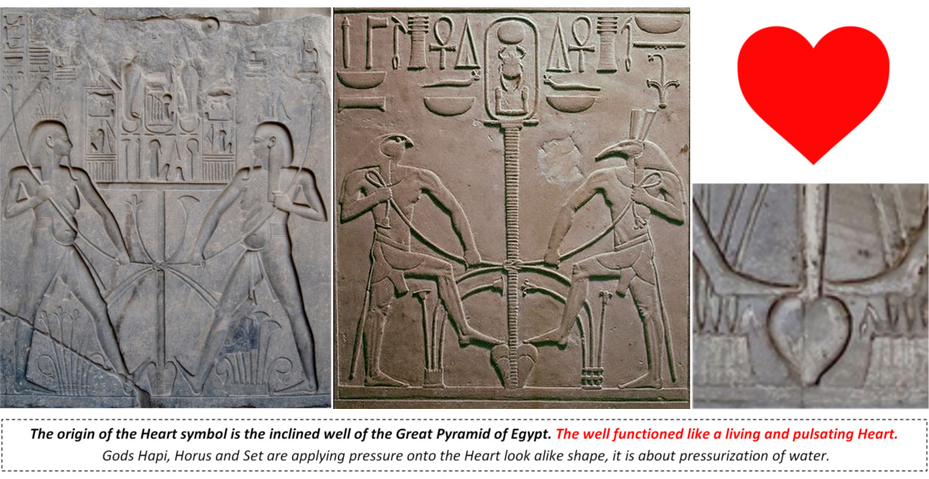
"Hapi (left), Horus and Set (center), performing the Sema-Tawy ritual (lotus and papyrus entwined; the unification of Upper and Lower Egypt)". Traditionally this is a ceremony performed by Hapi, God of the annual inundation of the Nile. https://fr.wikipedia.org/wiki/Deux_Terres#/media/Fichier:Luxor_Tempel_15.jpg
19.21 The origin of the Heart symbol loss of knowledge
Many theories are trying to explain the origin of the Heart symbol by its resemblance with the shape of ivy leaves, Silphium seed pod, breasts, buttocks or other parts of the human anatomy.
But it can't be that simple, because if it was, nothing would explain why the knowledge of the origin would have been lost over time : on Valentine's Day, we wouldn't offer roses to the loved one but ivy leaves or Silphium seed pods.
If it was that simple, the real meaning of the heart symbol would have been transmitted from one generation to another.
19.22 The ancient Egyptian anatomical point of view of the inclined well functioning
What is striking about the above images that inspired Hindu mythology for the Churning of the Ocean representations, is that there is what looks like a perfect Heart symbol.
In my opinion, if it looks like a Heart symbol, it is because it is the origin of the Heart symbol.
The Churning of the Ocean representations are the key to understand the ancient Egyptian initial version : the churning is about the pounding of the inclined well waters by the impactor. It is about the inclined well. Hindu mythology is looking at the well from the outside point of view, and they included the impactor, but the ancient Egyptians didn't : they looked at the well from an anatomical point of view.
Ancient Egyptians looked at the inclined well like it was a functioning living heart.
19.23 The inclined well functioning true origin of the Heart symbol
I may have written in previous posts (before "The Pyramids of the Cold"), that the Grand Gallery was seen as the heart of the Great Pyramid, because it was in the gallery where all the physical work was done : the Grand Gallery was the place of the act of towing. The Grand Gallery was the "Hauling cavern of the Underworld".
But if I did, I was obviously wrong : the Heart of the Great Pyramid, as seen by ancient Egyptians themselves, was the inclined well. And that is the origin of the Heart symbol.
If the knowledge of the origin of the Heart symbol was lost somewhere in time, it is because the knowledge of what really was the Great Pyramid was lost in the first place.
19.24 The true nature of the ancient Egyptian Heart symbol look alike
I don't know what really is representing what looks like the heart symbol here, it could be as simple as 2 pouches of water that are just here so that the 2 characters could show they were pressurizing water with their feet, but it could also be a representation of a real important part of the well, I really don't know.
19.25 The intercourse metaphor is the reason why the Heart symbol has been associated with Love
We've already seen two metaphors about the inclined well functioning, but there is a third one that is most probably explaining the fact that the Heart symbol has been associated with love, passion and romance : the intercourse metaphor.
The endless pounding of the impactor into the waters of the well had associated it, and the curious shape that looks like a modern Heart as well, to the Love making.
Most probably this association wasn't conceived at all by the ones who designed this whole ancient Egyptian "religion", but people simply appropriated themselves the idea and made the Heart-like shape of the religious representations into the real Heart shape we know it today.

Operating process of the Great Pyramid of Giza for evaporative cooling of sodium carbonate natron Solvay manufacturing. Updated July 30, 2022 : implementation of "the Savior" block : the shock absorber block that protected the bottom of the inclined well structure from the released Taweret block at the shutdown procedure draining of the well.
19.26 Was 42 the daily Heart rate of the Great Pyramid of Egypt?
We'll see in Section 20 'The Weighing of the Heart' that when ancient Egyptians were talking about the Heart, they were referring to the heart of the Great Pyramid : the inclined well that functioned like a pulsating living heart.
In the crucial Spell 125 of the Egyptian Book of the Dead it is mentioned that the deceased person has to make a Negative Confession : "The Negative Confession (also known as The Declaration of Innocence) is a list of 42 sins which the soul of the deceased can honestly say it has never committed when it stands in judgment in the afterlife."
https://www.worldhistory.org/The_Negative_Confession/
Knowing that the whole Heart thing is about the inclined well, this number of 42 could be a very important data.
For some time know I evaluated the entire operating cycle duration of the Hauling beetle at something between 10 and 15 minutes, most of that time used to haul the impactor from its resting floating position in the well, up to the upper part of the Grand Gallery next to the top platform.
Let's say the entire team of the Grand Gallery was working 10 hours a day, from 8 am to 6 pm. With a 10 minutes cycle, it would have been possible for them to complete 60 cycles; and with a 15 minutes cycle that number comes down to 40 cycles.
It means that working 10 hours a day, the Hauling beetle could have been able to complete 42 complete cycles of a little less of 15 minutes each, assuming the Beetle was never stopped being operated and that the crewmembers would have been regularly relayed.
In short, 42 cycles could have been the daily objective of the Hauling beetle crewmembers.
42 could have been the daily Heart rate of the Great Pyramid of Egypt.
19.27 The creation of the myths about the inclined well
It is very hard to imagine what really looked like the pyramid when operated, but certainly as I've already discussed many times in posts previous to 'The Pyramids of the Cold', the Great Pyramid wouldn't have been completed; it would have pretty much looked like the lower part of the Bent Pyramid, and if this Bent Pyramid is precisely in 2 parts, it must certainly has to be related to that lower Great Pyramid part for cold production.
But if the impactor hit the waters of the well every 15 minutes and if the Grand Gallery was somehow close to be in midair, the sound of the whole thing would have been heard probably kilometers away.
Everybody in ancient Giza would have been able to hear it, 10 hours a day, every 15 minutes for most probably a period of 4 months (Section 20). Residents of Giza would have heard it but also everybody coming to Giza from foreign countries : visitors, merchants, domestic and foreign dignitaries, etc.
Of course, the biggest impression would have been caused by the breaking of the Bes wedging block and the release of the Taweret block resulting in the tremendous shock with the Savior block (granite plug #2).
Everybody heard it, and everybody talked about it. This is how the inclined well inspired so many myths in the ancient World.
19.28 Summary of the study : hidden behind the academic vision of the ancient Egyptian religion, a vast number of metaphors are describing some of the most advanced science and technological knowledge of that time : ancient Egyptian gods were nothing else than pharaohs' metaphoric self-glorifications of their theoretical and experimental scientific accomplishments in physics and chemistry.
Pharaohs used the power of Science to legitimate themselves as kings of Egypt : they forged an entire religion, based on science to rule their kingdom, and they presented that science as Magic.
The end game of this technological program that probably started on the very first Dynasty, was the Great Pyramid of Giza where evaporative cooling was engineered in the known part of the pyramid from the pressurized water produced in the inclined well, known today as the ascending passage.
The evaporative cold simply took advantage of the power of water, and was most probably necessary to cool down chemical manufacturing of sodium carbonate and sodium bicarbonate produced by an ammonia-soda Solvay process, as suggested by the very strong ammonia smell and the limestone kiln in the so-called burial chamber of the Red Pyramid. At that time, sodium carbonate was called natron, and it was the salt used for the mummification of the pharaohs (Sections 14, 15 and 16).
The cooling seems to have represented the most difficult part of the process, as suggested by the Step Pyramid's official name : according to scholars, the very first pyramid complex, the Step Pyramid of Djoser, was called "the refreshment of the Gods". No doubt that a more accurate translation would certainly be "the cooling of the Gods".
It means that ancient Egyptians were the first civilization to master a Solvay-like process for sodium carbonate manufacturing, long before it got reinvented in the 1800's in Europe. The key elements of that process is the temperature control of the chemical reactions (the cooling), and the dome shaped plate necessary for the counterflow chemical reactions to occur in an efficient way. That counterflow reaction plate is what really is the disc of Sabu.
As shown with Akhenaten and Nefertiti, the creation of the evaporative cold was the most sacred accomplishment of all (Section 17), and this is exactly what the Dendera Light is all about : the Dendera Light is the fog of microdroplets of liquid water that evaporates and creates the cold. Talking about the snake inside the Dendera Light Bulb : "The field surrounding Ra’s snake form is referred to in ancient Egyptian literature as protective magical energy in liquid form that all gods and pharaohs possess" (Faulkner, Section 2).
Everything that had been done in the Great Pyramid of Giza inspired most of the ancient Egyptian religion, and it had been glorified into what we know today as the Underworld.
The Underworld is referring to the chambers and passages of the Great Pyramid of Khufu, and in particular to the Grand Gallery where a hauling gantry beetle operated a wooden coffin shaped impactor that had a small nested granite block inside it. The impactor generated endlessly, over and over, maybe every 15 minutes the pressurized water that was then transformed into a fog of microdroplets inside the horizontal cooling passage.
The Grand Gallery of the Great Pyramid where the act of hauling was done, is the "Secret Hauling Cavern of the Underworld" described in the Amduat "Book of the Hidden Chamber".
The most important chamber of the Great Pyramid wasn't the King's chamber that only was the main water tank of the pyramid, but the Queen's chamber, the only one on the central axis of the pyramid. Because the Queen's chamber was inaccessible from the rest of the pyramid, it was glorified into the "Hidden Chamber of the Underworld" (Section 11), and because the Queen's chamber was the coolest place in the pyramid (about 5°C / 41°F), and with a constant 100% Humidity rate, this chamber was the one where the biggest amount of very hard salt encrustation had been documented by the first explorers of the pyramid in the 1800's and before it had been removed in 1998 by Zahi Hawass (Section 1). Very hard salt encrustation is the signature of the evaporative cooling process, even nowadays.
The most incredible thing is that pretty much everything I've just said, actually appears in one single myth, but it doesn't originate from ancient Egypt : it is the "Churning of the Ocean" Hindu myth that produces the immortal nectar Amrita. The fact is that the endless churning of water that ends up with the production of an elixir that gives eternal life, is exactly what were doing ancient Egyptians in the inclined well : natron was the salt used for the mummification of pharaohs.
Natron gave eternal life to pharaohs, just like the Amrita (Section 19).
Poster un commentaire

